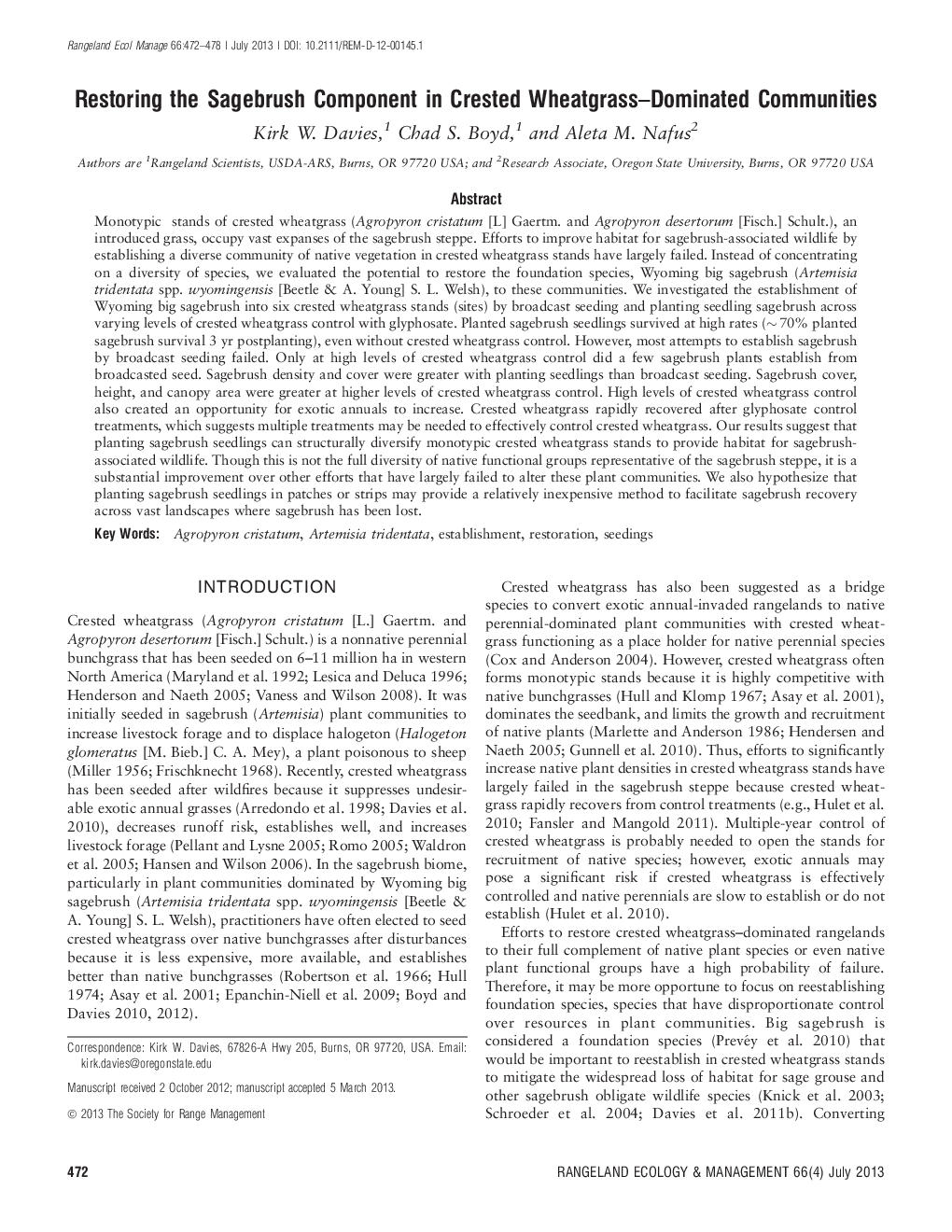| کد مقاله | کد نشریه | سال انتشار | مقاله انگلیسی | نسخه تمام متن |
|---|---|---|---|---|
| 4404427 | 1307162 | 2013 | 7 صفحه PDF | دانلود رایگان |
عنوان انگلیسی مقاله ISI
Restoring the Sagebrush Component in Crested Wheatgrass-Dominated Communities
دانلود مقاله + سفارش ترجمه
دانلود مقاله ISI انگلیسی
رایگان برای ایرانیان
موضوعات مرتبط
علوم زیستی و بیوفناوری
علوم کشاورزی و بیولوژیک
علوم کشاورزی و بیولوژیک (عمومی)
پیش نمایش صفحه اول مقاله

چکیده انگلیسی
Monotypic stands of crested wheatgrass (Agropyron cristatum [L] Gaertm. and Agropyron desertorum [Fisch.] Schult.), an introduced grass, occupy vast expanses of the sagebrush steppe. Efforts to improve habitat for sagebrush-associated wildlife by establishing a diverse community of native vegetation in crested wheatgrass stands have largely failed. Instead of concentrating on a diversity of species, we evaluated the potential to restore the foundation species, Wyoming big sagebrush (Artemisia tridentata spp. wyomingensis [Beetle & A. Young] S. L. Welsh), to these communities. We investigated the establishment of Wyoming big sagebrush into six crested wheatgrass stands (sites) by broadcast seeding and planting seedling sagebrush across varying levels of crested wheatgrass control with glyphosate. Planted sagebrush seedlings survived at high rates (â¼â70% planted sagebrush survival 3 yr postplanting), even without crested wheatgrass control. However, most attempts to establish sagebrush by broadcast seeding failed. Only at high levels of crested wheatgrass control did a few sagebrush plants establish from broadcasted seed. Sagebrush density and cover were greater with planting seedlings than broadcast seeding. Sagebrush cover, height, and canopy area were greater at higher levels of crested wheatgrass control. High levels of crested wheatgrass control also created an opportunity for exotic annuals to increase. Crested wheatgrass rapidly recovered after glyphosate control treatments, which suggests multiple treatments may be needed to effectively control crested wheatgrass. Our results suggest that planting sagebrush seedlings can structurally diversify monotypic crested wheatgrass stands to provide habitat for sagebrush-associated wildlife. Though this is not the full diversity of native functional groups representative of the sagebrush steppe, it is a substantial improvement over other efforts that have largely failed to alter these plant communities. We also hypothesize that planting sagebrush seedlings in patches or strips may provide a relatively inexpensive method to facilitate sagebrush recovery across vast landscapes where sagebrush has been lost.
ناشر
Database: Elsevier - ScienceDirect (ساینس دایرکت)
Journal: Rangeland Ecology & Management - Volume 66, Issue 4, July 2013, Pages 472-478
Journal: Rangeland Ecology & Management - Volume 66, Issue 4, July 2013, Pages 472-478
نویسندگان
Kirk W. Davies, Chad S. Boyd, Aleta M. Nafus,